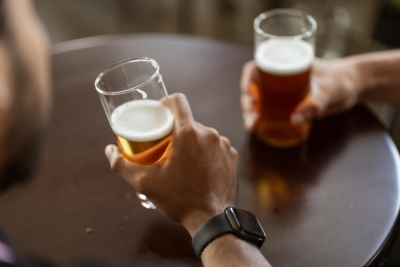Non-alcoholic beers are beverages that, through changes in the brewing process, have no, or almost no, alcohol. In some places, such as Brazil, a beer can be classified as “alcoholic free” if it has an alcohol content of less than 0.5%*.
Although the understanding of the effect of non-alcoholic beers on drinking behavior is still low, some studies have provided evidence on how the consumer population can use this type of beverage. Research analyzing non-alcoholic beers and “Low-Alcohol” beers (that is, with a lower alcohol content than a conventional beer) has indicated a potential for substituting beverages with a higher content for those without alcohol or with a lower alcohol content (1–3 ). These data, however, are still preliminary, and specialists point out that a greater body of evidence is needed so that public policies can make use of initiatives that seek to encourage the consumption of these types of drinks in people who already drink, as a way of reducing damage (4).
A recent study sought to analyze the behavior of Spaniards regarding the purchase of non-alcoholic beer (1). The analysis of more than 1700 households that purchased non-alcoholic beers showed a 5.5% reduction in the purchase of alcoholic beers after the first purchase of zero beers. Furthermore, for more than 330 households that purchased a brand of non-alcoholic beer – but had never before purchased an alcoholic beer of the same brand – a 14% reduction in alcohol consumption was observed, due largely to a reduction in purchases of wine and spirits.
An important point about non-alcoholic beers stems from the concern that they serve as a gateway to bring abstemious people closer to alcohol consumption. Aiming to study this association, a study analyzing purchase data from more than 64,000 British households observed that, for this sample, the association was not present (3). Households that purchased non-alcoholic beers were less likely to purchase alcoholic beers of the same brand. As for households that had purchased beers with alcohol, the introduction of non-alcoholic beers (or with a lower alcohol content) was associated with a reduction in the purchase of alcoholic beers.
The potential of non-alcoholic beers to reduce the impact of harmful alcohol consumption depends on the socioeconomic profile of consumers of such types of beverages. If the substitution of alcoholic beverages for non-alcoholic beers only occurs in the richest social classes, the impact on public health is considerably lower compared to the possibility of this consumption of non-alcoholic beverages occurring in all social classes. Seeking to analyze these hypotheses, a study analyzing data from British households and individuals compared data on the purchase and consumption of low-alcohol or non-alcoholic beers with the social profile of these consumers (2). In general terms, it was observed that non-alcoholic or low-alcohol beers were more consumed by people who consumed more alcohol, mostly men, young adults and with high income and social profile. These data led the authors to conclude that the contribution of non-alcoholic beers to reducing alcohol consumption is still limited and that the ideal would be to reach other social profiles of drinkers as well.
In general, the scientific literature in the area points out that there is potential in the use of non-alcoholic beers as a way of reducing total alcohol consumption, but more research is needed to assess the effects and risks (4). These considerations were accepted by WHO, which released a brief report in 2023 (5) pointing out the impact of low-alcohol or non-alcoholic beers on public health. In this report, WHO reiterates that research in the area is still inconclusive, and that these drinks should not yet be considered as foci for public policies. On the other hand, they encourage the exploration of individual strategies in order to replace beverages with a higher alcohol content by non-alcoholic (or low-alcohol) beverages. As it is an emerging market that has been advancing both due to an increase in the appreciation of the taste of non-alcoholic beers and a greater search for healthy lifestyles (6), more research in the area is necessary.
It should be noted that, as it cannot be guaranteed that non-alcoholic beers do not contain any traces of alcohol, these drinks are not recommended for pregnant women or for people who cannot control their consumption. In fact, even though there is no consensus on the subject, it is recommended that many of the “Zero Alcohol” situations also apply to non-alcoholic beers.
* DECREE Number 6.871: https://www.planalto.gov.br/ccivil_03/_ato2007-2010/2009/decreto/d6871.htm











